Superior Heavy Metal Ion Adsorption Capacity in Aqueous Solution by High-Density Thiol-Functionalized Reduced Graphene Oxides
Abstract
1. Introduction
2. Results and Discussion
2.1. Structural Characterization of m-RGOs
2.2. Elemental Analysis of m-RGOs
2.3. Importance of –SH Groups in Pb2+ Ion Removal
2.4. Effect of pH on the Percent Removal of Pb2+ Ions Using m-RGOs
2.5. Effect of Contact Time on the Percentage Removal of Pb2+ Using m-RGOs
3. Materials and Methods
3.1. Synthesis of m-RGOs
3.2. Characterization of m-RGOs
3.3. Adsorption Experiments
4. Conclusions
Supplementary Materials
Author Contributions
Funding
Institutional Review Board Statement
Informed Consent Statement
Data Availability Statement
Conflicts of Interest
Sample Availability
References
- Ge, F.; Li, M.M.; Ye, H.; Zhao, B.X. Effective removal of heavy metal ions Cd2+, Zn2+, Pb2+, Cu2+ from aqueous solution by polymer-modified magnetic nanoparticles. J. Hazard. Mater. 2012, 211, 366–372. [Google Scholar] [CrossRef]
- Jang, S.H.; Min, B.G.; Jeong, Y.G.; Lyoo, W.S.; Lee, S.C. Removal of lead ions in aqueous solution by hydroxyapatite/polyurethane composite foams. J. Hazard. Mater. 2008, 152, 1285–1292. [Google Scholar] [CrossRef] [PubMed]
- José, A.; Jesús, M.A.; Amaya, A.; Montña, L.; Victoria, G. Aqueous heavy metals removal by adsorption on amine-functionalized mesoporous silica. J. Hazard. Mater. 2009, 169, 213–221. [Google Scholar]
- Hua, M.; Zhang, S.; Pan, B.; Zhang, W.; Lv, L.; Zhang, Q. Heavy metal removal from water/wastewater by nanosized metal oxides: A review. J. Hazard. Mater. 2012, 211, 317–331. [Google Scholar] [CrossRef] [PubMed]
- Zahra, T.K.; Marjan, T.; Aliyeh, Y.; Hossein, E. Removal of Cd(II) from Aqueous Solution by Using Polyaniline/Polystyrene Nanocomposite. J. Vinyl Addit. Technol. 2012, 152, 1285–1292. [Google Scholar]
- Madadrang, C.J.; Kim, H.Y.; Gao, G.; Wang, N.; Zhu, J.; Feng, H.; Gorring, M.; Kasner, M.L.; Hou, S. Adsorption Behavior of EDTA-Graphene Oxide for Pb (II) Removal. ACS Appl. Mater. 2012, 4, 1186–1193. [Google Scholar] [CrossRef] [PubMed]
- Sis, H.; Uysal, T. Removal of heavy metal ions from aqueous medium using Kuluncak(Malatya) vermiculites and effect of precipitation on removal. Appl. Clay Sci. 2014, 95, 369–376. [Google Scholar] [CrossRef]
- Barakat, M.A.; Schmidt, E. Polymer-enhanced ultrafiltration process for heavy metals removal from industrial wastewater. Desalination 2010, 256, 90–93. [Google Scholar] [CrossRef]
- Hajdu, I.; Bodnár, M.; Csikós, Z.; Wei, S.; Daróczi, L.; Kovács, B.; Gyóri, Z.; Tamás, J.; Borbély, J. Combined nano-membrane technology for removal of lead ions. J. Membr. Sci. 2012, 409–410, 44–53. [Google Scholar] [CrossRef]
- Hosseini, S.M.; Alibakhshi, H.; Jashni, E.; Parvizian, F.; Shen, J.N.; Taheri, M.; Ebrahimi, M.; Rafiei, N. A novel layer-by-layer heterogeneous cation exchange membrane for heavy metal ions removal from water. J. Hazard. Mater. 2020, 381, 120884. [Google Scholar] [CrossRef]
- Wu, G.; Kang, H.; Zhang, X.; Shao, H.; Chu, L.; Ruan, C. A critical review on the bio-removal of hazardous heavy metals from contaminated soils: Issues, progress, eco-environmental concerns and opportunities. J. Hazard. Mater. 2010, 174, 1–8. [Google Scholar] [CrossRef] [PubMed]
- Fu, K.; Liu, X.; Yu, D.; Luo, J.; Wang, Z.; Crittenden, J.C. Highly Efficient and Selective Hg(II) Removal from Water Using Multilayered Ti3C2Ox MXene via Adsorption Coupled with Catalytic Reduction Mechanism. Environ. Sci. Technol. 2020, 54, 16212–16220. [Google Scholar] [CrossRef] [PubMed]
- Bazrafshan, E.; Mohammadi, L.; Moghaddam, A.A.; Mahvi, A.H. Heavy metals removal from aqueous environments by electrocoagulation process– a systematic review. J. Environ. Health Sci. Eng. 2015, 13, 84. [Google Scholar] [CrossRef] [PubMed]
- Seco, A.; Marzal, P.; Gabaldón, C. Adsorption of Heavy Metals from Aqueous Solutions onto Activated Carbon in Single Cu and Ni Systems and in Binary Cu-Ni, Cu-Cd and Cu-Zn Systems. J. Chem. Technol. Biotechnol. 1997, 68, 23–30. [Google Scholar] [CrossRef]
- Payne, K.B.; Abdel-Fattah, T.M. Adsorption of Divalent Lead Ions by Zeolites and Activated Carbon: Effects of pH, Temperature, and Ionic Strength. J. Environ. Sci. Health Part A Toxic/Hazard. Subst. Environ. Eng. 2004, 39, 2275–2291. [Google Scholar] [CrossRef]
- Gupta, G.; Torres, N. Use of fly ash in reducing toxicity of and heavy metals in wastewater effluent. J. Hazard. Mater. 1998, 57, 243–248. [Google Scholar] [CrossRef]
- Schiban, M.; Klasnja, M.; Skrbic, B. Modified hardwood sawdust as adsorbent of heavy metal ions from water. Wood Sci. Technol. 2006, 40, 217–227. [Google Scholar] [CrossRef]
- An, H.K.; Park, B.Y.; Kim, D.S. Crab shell for the removal of heavy metals from aqueous solution. Water Res. 2001, 35, 3551–3556. [Google Scholar] [CrossRef]
- Amuda, O.S.; Giwa, A.A.; Bello, I.A. Removal of heavy metal from industrial wastewater using modified activated coconut shell carbon. Biochem. Eng. J. 2007, 36, 174–181. [Google Scholar] [CrossRef]
- Homagai, P.L.; Ghimire, K.N.; Inoue, K. Adsorption behavior of heavy metals onto chemically modified sugarcane bagasse. Bioresour. Technol. 2010, 101, 2067–2069. [Google Scholar] [CrossRef]
- Lee, D.H.; Moon, H. Adsorption Equilibrium of Heavy Metals on Natural Zeolites. Korean. J. Chem. Eng. 2001, 18, 247–256. [Google Scholar] [CrossRef]
- Chuah, T.G.; Jumasiah, A.; Azni, I.; Katayon, S.; Thomas-Choong, S.Y. Rice husk as a potentially low-cost biosorbent for heavy metal and dye removal: An overview. Desalination 2005, 175, 305–316. [Google Scholar] [CrossRef]
- Gadde, R.R.; Laitinen, H.A. Studies of Heavy Metal Adsorption by Hydrous Iron and Manganese Oxides. Anal. Chem. 1974, 46, 2022–2026. [Google Scholar] [CrossRef]
- Yao, W.; Wang, J.; Wang, P.; Wang, X.; Yu, S.; Zou, Y.; Hou, J.; Hayat, T.; Alsaedi, A.; Wang, X. Synergistic coagulation of GO and secondary adsorption of heavy metal ions on Ca/Al layered double hydroxides. Environ. Pollut. 2017, 229, 827–836. [Google Scholar] [CrossRef] [PubMed]
- Usman, T.M.; Xintai, S.; Mengqi, Z.; Yinnian, L.; Ronglan, W.; Dejun, C. Preparation of hydroxypropyl-cyclodextrin-graphene / Fe3O4 and its adsorption properties for heavy metals. Surf. Interfaces 2019, 16, 43–49. [Google Scholar]
- Huang, Y.; Gong, Y.; Tang, J.; Xia, S. Effective removal of inorganic mercury and methylmercury from aqueous solution using novel thiol-functionalized graphene oxide/Fe-Mn composite. J. Hazard. Mater. 2019, 366, 130–139. [Google Scholar] [CrossRef]
- Zhang, H.; Liu, X.; Tian, L.; Tang, Y.; Shi, Z.; Xiao, Y.; Wu, Z.; Zhu, Y.; Guo, Q.; Peng, Z. Preparation of Functionalized Graphene oxide Composite Spheres and Removal of Cu2+ and Pb2+ from Wastewater. Water Air Soil Pollut. 2022, 233, 512. [Google Scholar] [CrossRef]
- Luo, Y.R. Handbook of Bond Dissociation Energies in Organic Compounds; CRC Press: Boca Raton, FL, USA, 2002; pp. 9–65. [Google Scholar]
- Leyva-Ramos, R.; Berber-Mendoza, M.S.; Salazar-Rabago, J.; Guerrero-Coronado, R.M.; Mendoza-Barron, J. Adsorption of lead(II) from aqueous solution onto several types of activated carbon fibers. Adsorption 2011, 17, 515–526. [Google Scholar] [CrossRef]
- Pesavento, M.; Profumo, A.; Alberti, G.; Conti, F. Adsorption of lead(II) and copper(II) on activated carbon by complexation with surface functional groups. Chim. Acta 2003, 480, 171–180. [Google Scholar] [CrossRef]
- Li, Y.H.; Wang, S.; Wei, J.; Zhang, X.; Xu, C.; Luan, Z.; Wu, D.; Wei, B. Lead adsorption on carbon nanotubes. Chem. Acta 2002, 357, 263–266. [Google Scholar] [CrossRef]
- Abraham, T.N.; Kumar, R.; Misra, R.K.; Jain, S.K. Poly(vinyl alcohol)-Based MWCNT Hydrogel for Lead Ion oval from Contaminated Water. J. Appl. Polym. Sci. 2012, 125, E670–E674. [Google Scholar] [CrossRef]
- Zhang, H.; Jeon, K.W.; Seo, D.K. Equipment-Free Deposition of Graphene-Based Molybdenum Oxide Nanohybrid Langmuir−Blodgett Films for Flexible Electrochromic Panel Application. Appl. Mater. Interfaces 2016, 8, 21539–21544. [Google Scholar] [CrossRef] [PubMed]
- Musico, Y.; Santos, C.M.; Dalida, M.; Rodrigues, D.F. Improved removal of lead(II) from water using a polymer-based graphene oxide nanocomposite. J. Mater. Chem. 2013, 1, 3789–3796. [Google Scholar] [CrossRef]
- Pyrzy’nska, K.; Bystrzejewski, M. Comparative study of heavy metal ions sorption onto activated carbon, carbon nanotubes, and carbon-encapsulated magnetic nanoparticles. Colloids Surf. A 2010, 362, 102–109. [Google Scholar] [CrossRef]

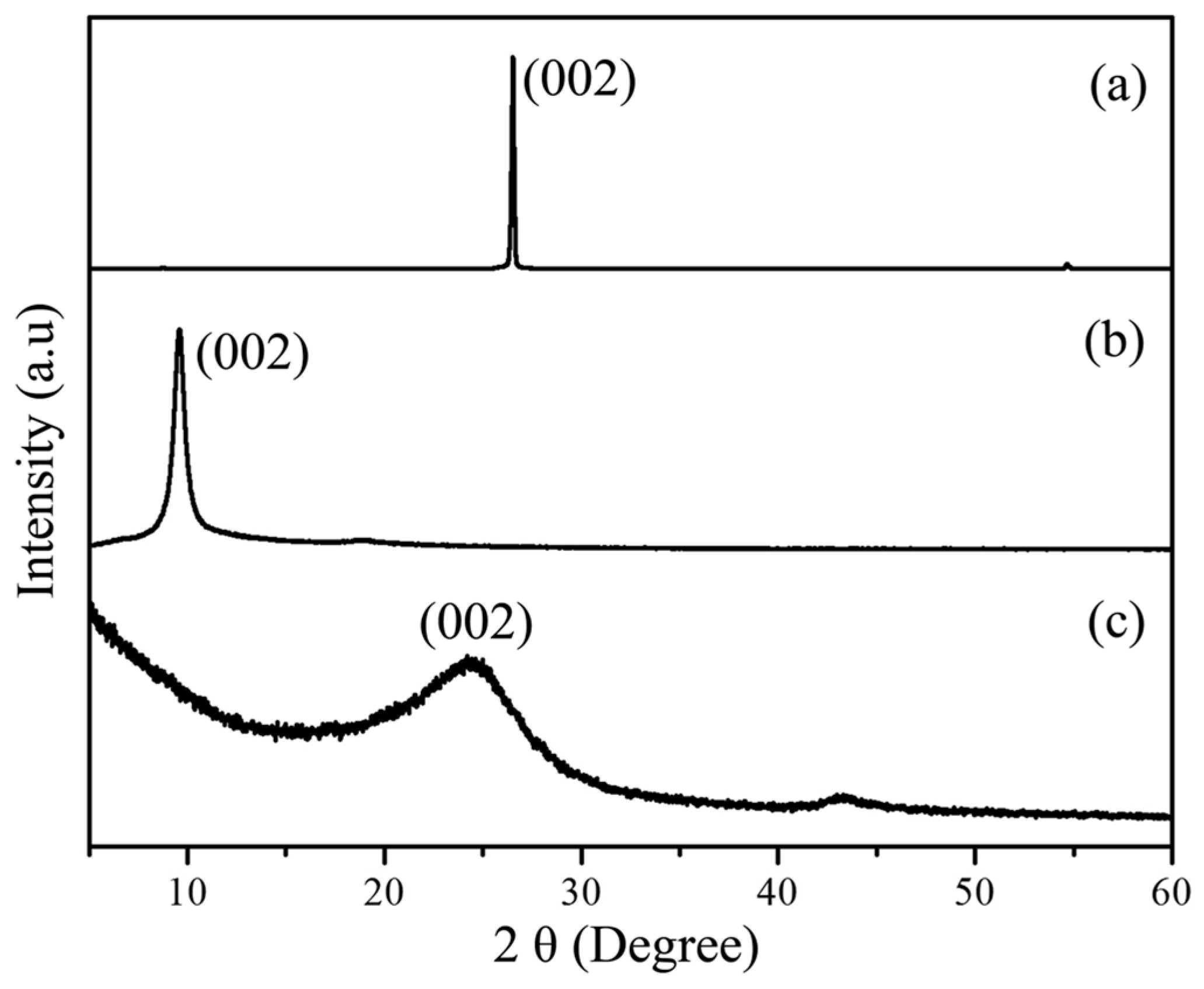

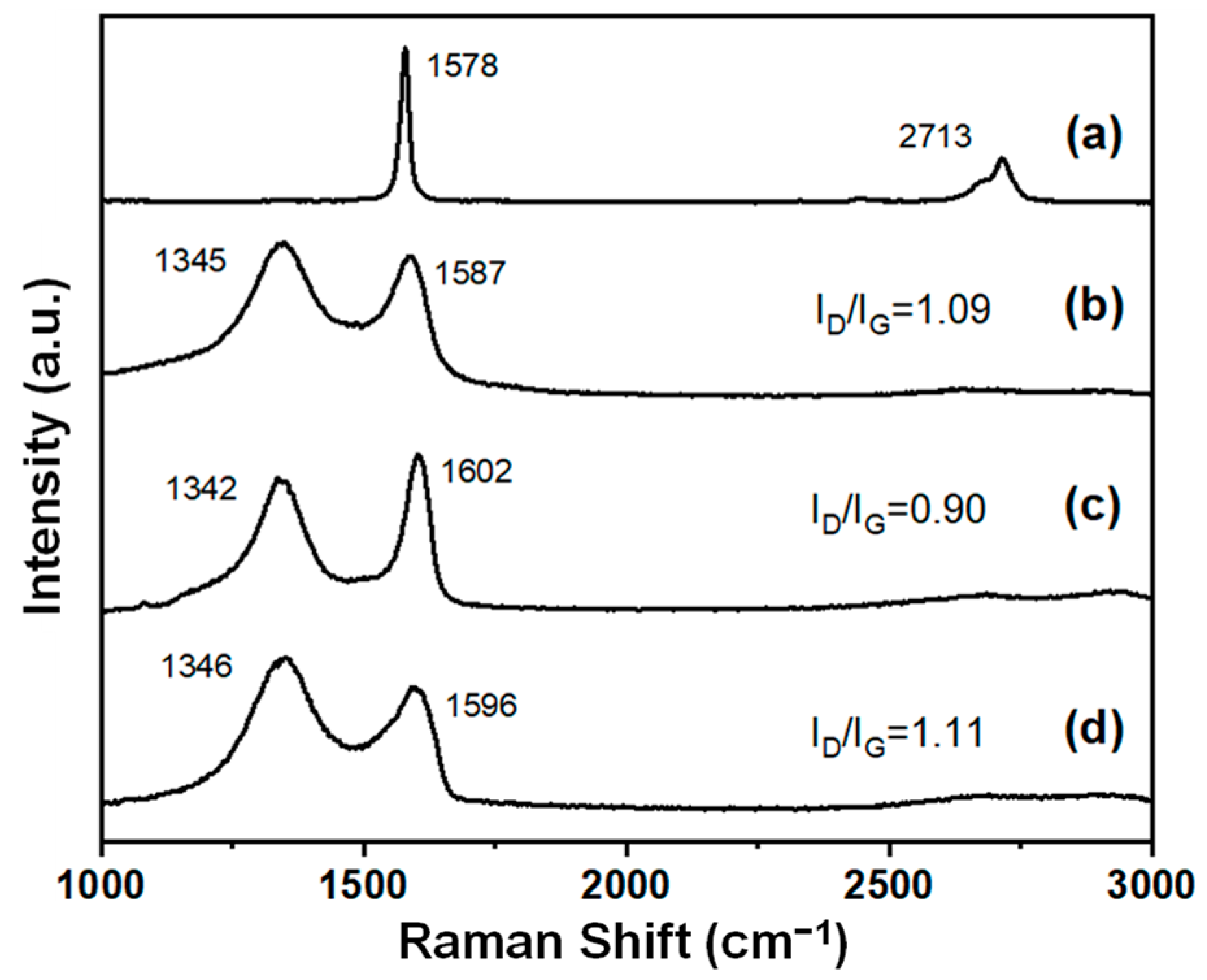
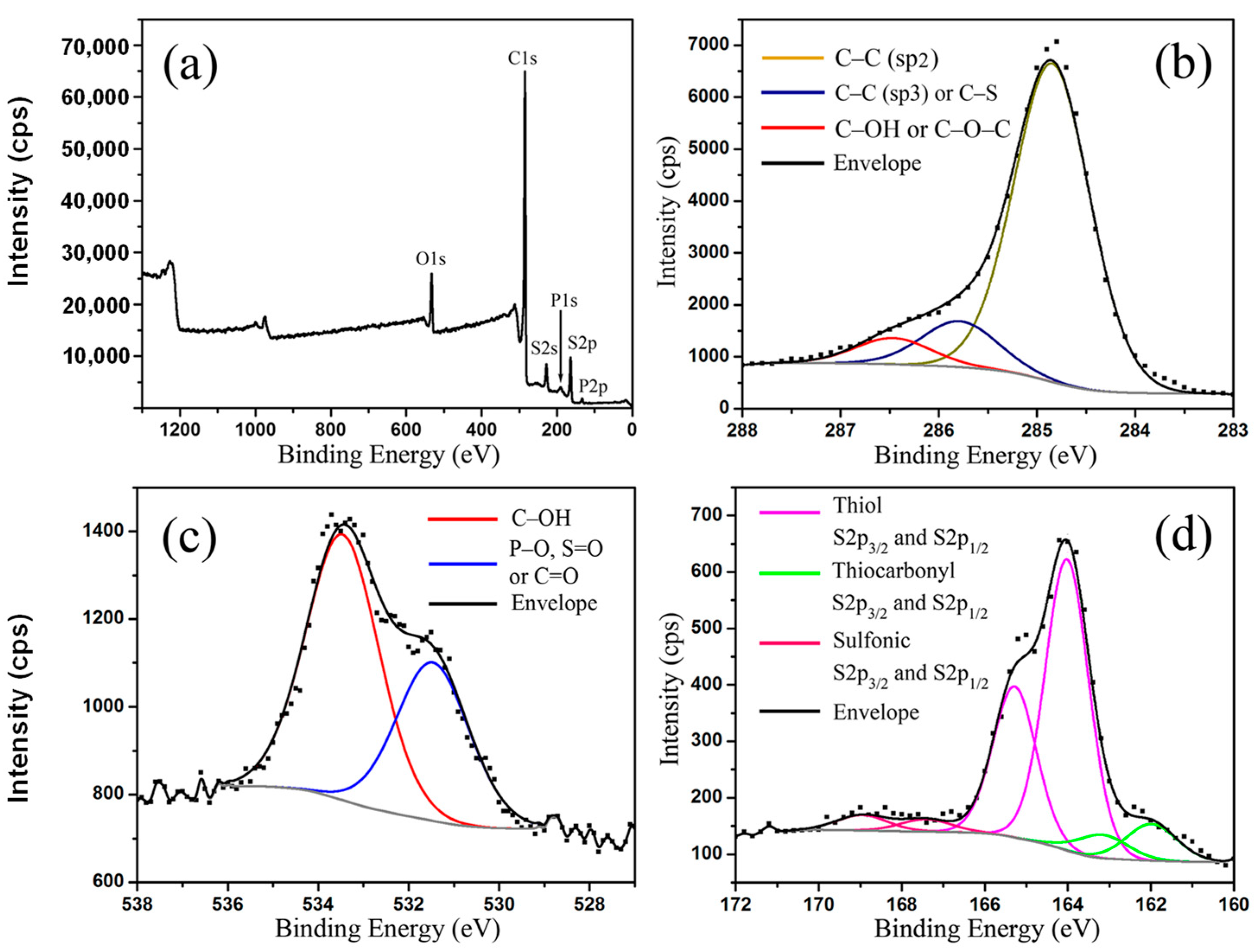
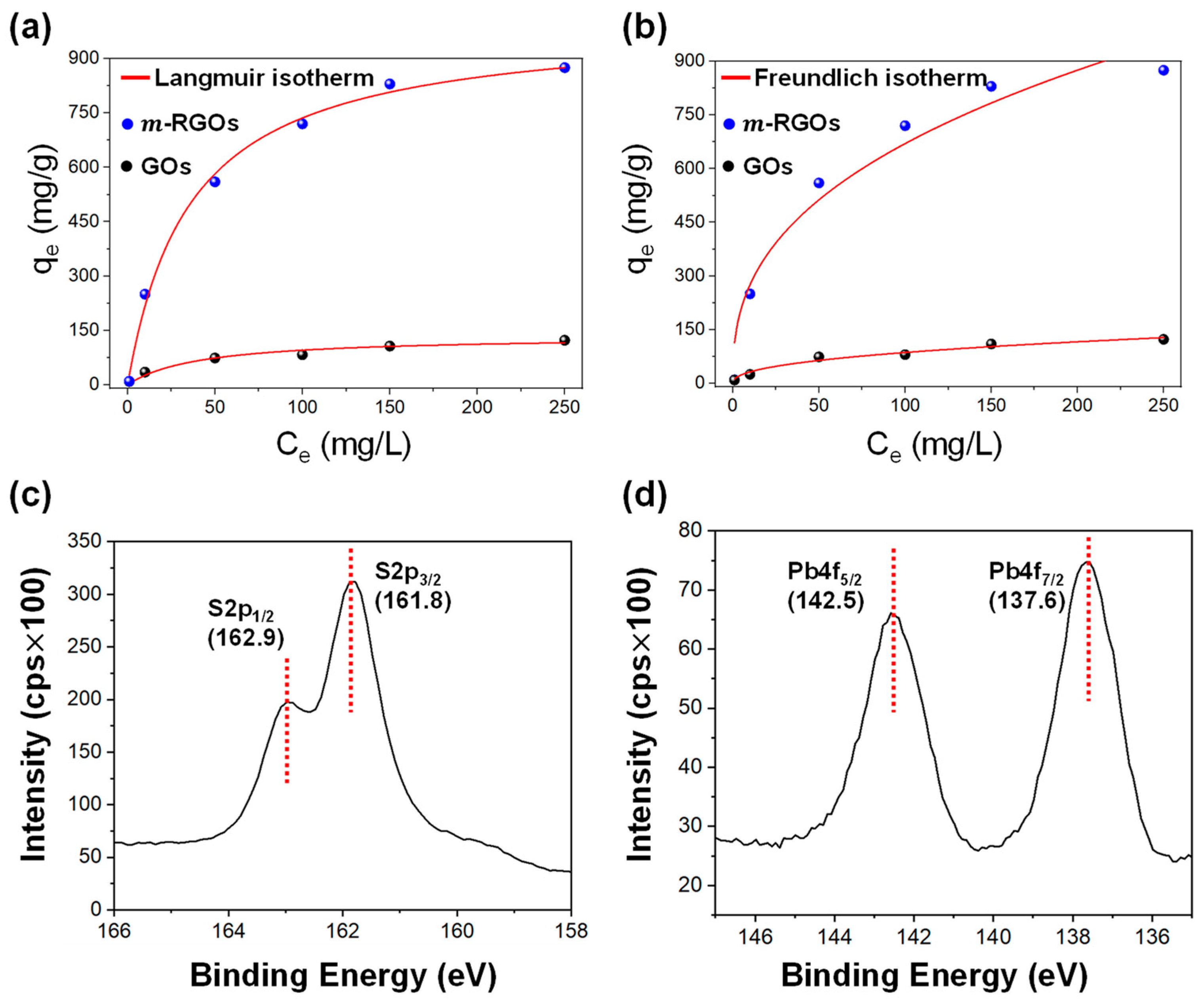
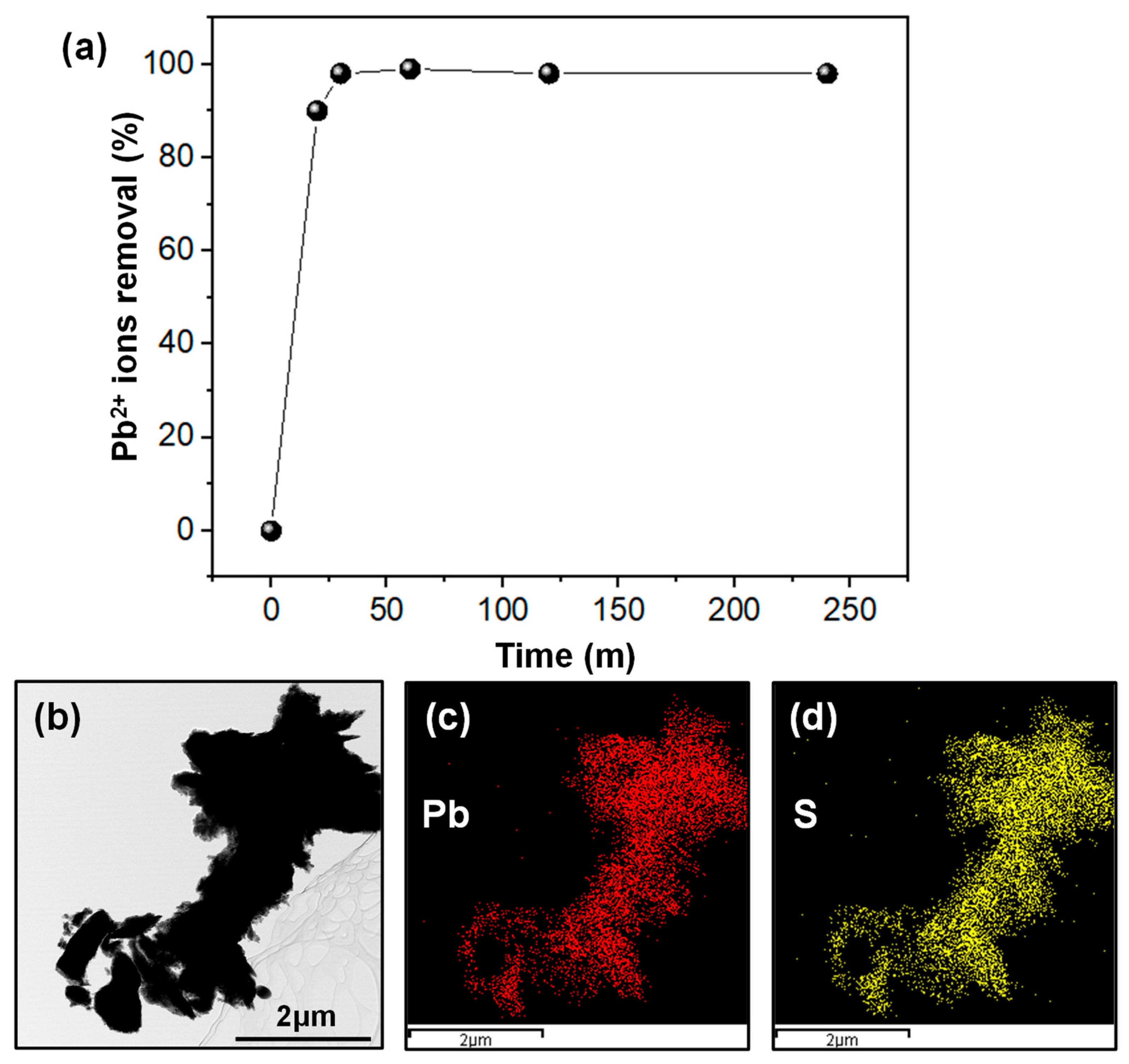
| Adsorbents | Langmuir | Freundlich | ||||
|---|---|---|---|---|---|---|
| KL (L/mg) | qmax (mg/g) | R2 | KF (mg/g) (mg/L)1/n | n | R2 | |
| m-RGOs | 0.028 | 998 | 0.995 | 113 | 2.59 | 0.958 |
| GO | 0.024 | 135 | 0.957 | 11 | 2.13 | 0.966 |
Disclaimer/Publisher’s Note: The statements, opinions and data contained in all publications are solely those of the individual author(s) and contributor(s) and not of MDPI and/or the editor(s). MDPI and/or the editor(s) disclaim responsibility for any injury to people or property resulting from any ideas, methods, instructions or products referred to in the content. |
© 2023 by the authors. Licensee MDPI, Basel, Switzerland. This article is an open access article distributed under the terms and conditions of the Creative Commons Attribution (CC BY) license (https://creativecommons.org/licenses/by/4.0/).
Share and Cite
Kim, H.-G.; Bae, J.-S.; Hwang, I.; Kim, S.-H.; Jeon, K.-W. Superior Heavy Metal Ion Adsorption Capacity in Aqueous Solution by High-Density Thiol-Functionalized Reduced Graphene Oxides. Molecules 2023, 28, 3998. https://doi.org/10.3390/molecules28103998
Kim H-G, Bae J-S, Hwang I, Kim S-H, Jeon K-W. Superior Heavy Metal Ion Adsorption Capacity in Aqueous Solution by High-Density Thiol-Functionalized Reduced Graphene Oxides. Molecules. 2023; 28(10):3998. https://doi.org/10.3390/molecules28103998
Chicago/Turabian StyleKim, Ho-Geun, Jong-Seong Bae, Injoo Hwang, Sung-Hoon Kim, and Ki-Wan Jeon. 2023. "Superior Heavy Metal Ion Adsorption Capacity in Aqueous Solution by High-Density Thiol-Functionalized Reduced Graphene Oxides" Molecules 28, no. 10: 3998. https://doi.org/10.3390/molecules28103998
APA StyleKim, H.-G., Bae, J.-S., Hwang, I., Kim, S.-H., & Jeon, K.-W. (2023). Superior Heavy Metal Ion Adsorption Capacity in Aqueous Solution by High-Density Thiol-Functionalized Reduced Graphene Oxides. Molecules, 28(10), 3998. https://doi.org/10.3390/molecules28103998







